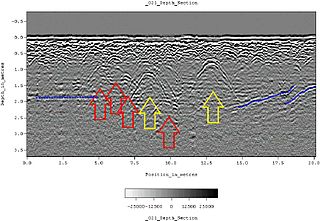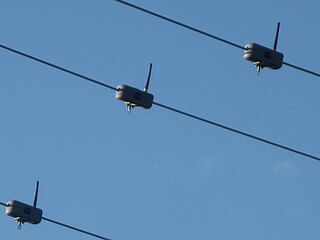
Network topology is the arrangement of the elements of a communication network. Network topology can be used to define or describe the arrangement of various types of telecommunication networks, including command and control radio networks, industrial fieldbusses and computer networks.
In a telecommunications network, a link is a communication channel that connects two or more devices for the purpose of data transmission. The link may be a dedicated physical link or a virtual circuit that uses one or more physical links or shares a physical link with other telecommunications links.
Data transmission is the transfer of data over a point-to-point or point-to-multipoint communication channel. Examples of such channels are copper wires, optical fibers, wireless communication channels, storage media and computer buses. The data are represented as an electromagnetic signal, such as an electrical voltage, radiowave, microwave, or infrared signal.
In the seven-layer OSI model of computer networking, the physical layer or layer 1 is the first and lowest layer. This layer may be implemented by a PHY chip.
In information technology, header refers to supplemental data placed at the beginning of a block of data being stored or transmitted. In data transmission, the data following the header is sometimes called the payload or body.

Ground-penetrating radar (GPR) is a geophysical method that uses radar pulses to image the subsurface. This nondestructive method uses electromagnetic radiation in the microwave band of the radio spectrum, and detects the reflected signals from subsurface structures. GPR can have applications in a variety of media, including rock, soil, ice, fresh water, pavements and structures. In the right conditions, practitioners can use GPR to detect subsurface objects, changes in material properties, and voids and cracks.
Schweitzer Engineering Laboratories, Inc. (SEL) designs, manufactures, and supports products and services ranging from generator and transmission protection to distribution automation and control systems. Founded in 1982 by Edmund O. Schweitzer III, SEL shipped the world's first digital protective relay. Presently, the company designs and manufactures embedded system products for protecting, monitoring, control, and metering of electric power systems.
Network Utility is an application included with macOS that provides a variety tools that can be used related to computer network information gathering and analysis.

The Telecommunications Industry Association (TIA) is accredited by the American National Standards Institute (ANSI) to develop voluntary, consensus-based industry standards for a wide variety of Information and Communication Technologies (ICT) products, and currently represents nearly 400 companies. TIA's Standards and Technology Department operates twelve engineering committees, which develop guidelines for private radio equipment, cellular towers, data terminals, satellites, telephone terminal equipment, accessibility, VoIP devices, structured cabling, data centers, mobile device communications, multimedia multicast, vehicular telematics, healthcare ICT, machine to machine communications, and smart utility networks.

In electrical engineering, a load profile is a graph of the variation in the electrical load versus time. A load profile will vary according to customer type, temperature and holiday seasons. Power producers use this information to plan how much electricity they will need to make available at any given time. Teletraffic engineering uses a similar load curve.

Stone & Webster was an American engineering services company based in Stoughton, Massachusetts. It was founded as an electrical testing lab and consulting firm by electrical engineers Charles Stone and Edwin S. Webster in 1889. In the early 20th century, Stone & Webster was known for operating streetcar systems in many cities across the United States; examples include Dallas, Houston and Seattle. The company grew to provide engineering, construction, environmental, and plant operation and maintenance services, and it has long been involved in power generation projects, starting with hydroelectric plants of the late 19th-century; and with most American nuclear power plants.

SP Group ; formerly known as Singapore Power, is a government-owned electricity and gas distribution company in Singapore. Through its subsidiaries, the company is the sole electrical grid and gas grid operator in Singapore, and provides electricity and gas transmission, distribution services, and market support services to more than a million customers in Singapore.

Telecommunications Engineering is an engineering discipline centered on electrical and computer engineering which seeks to support and enhance telecommunication systems. The work ranges from basic circuit design to strategic mass developments. A telecommunication engineer is responsible for designing and overseeing the installation of telecommunications equipment and facilities, such as complex electronic switching systems, and other plain old telephone service facilities, optical fiber cabling, IP networks, and microwave transmission systems. Telecommunications engineering also overlaps with broadcast engineering.
Quanta Services is an American corporation that provides infrastructure services for electric power, pipeline, industrial and communications industries. Capabilities include the planning, design, installation, program management, maintenance and repair of most types of network infrastructure. In June 2009, Quanta Services was added to the S&P 500 index, replacing Ingersoll-Rand.
IEC 60870 part 6 is one of the IEC 60870 set of standards which define systems used for telecontrol in electrical engineering and power system automation applications. The IEC Technical Committee 57 have developed part 6 to provide a communication profile for sending basic telecontrol messages between two systems which is compatible with ISO standards and ITU-T recommendations.

An electrical grid, electric grid or power grid, is an interconnected network for delivering electricity from producers to consumers. It consists of:
Geoprofessions is a term coined by the Geoprofessional Business Association to connote various technical disciplines that involve engineering, earth and environmental services applied to below-ground (“subsurface”), ground-surface, and ground-surface-connected conditions, structures, or formations. The principal disciplines include, as major categories:

A Wireless powerline sensor hangs from an overhead power line and sends measurements to a data collection system. Because the sensor does not contact anything but a single live conductor, no high-voltage isolation is needed. The sensor, installed simply by clamping it around a conductor, powers itself from energy scavenged from electrical or magnetic fields surrounding the conductor being measured. Overhead power line monitoring helps distribution system operators provide reliable service at optimized cost.
The Energy Networks Association (ENA) is the industry body funded by UK gas and electricity transmission and distribution licence holders.
Subsurface utility engineering (SUE) refers to a branch of engineering that involves managing certain risks associated with utility mapping at appropriate quality levels, utility coordination, utility relocation design and coordination, utility condition assessment, communication of utility data to concerned parties, utility relocation cost estimates, implementation of utility accommodation policies, and utility design.
The field of engineering dealing with the locating and mapping subsurface utilities is termed as Subsurface Utility Engineering (SUE).








